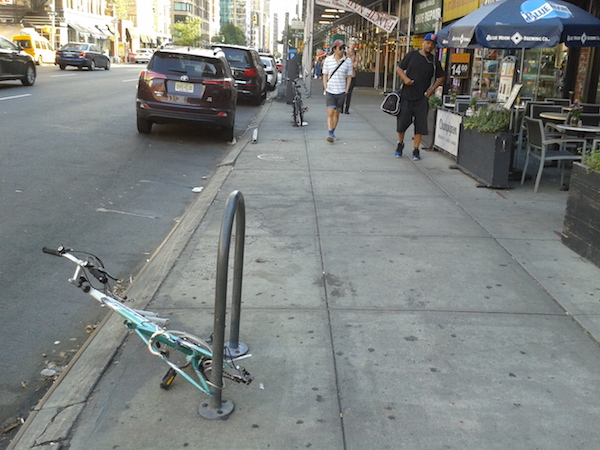
BY ALEX ELLEFSON | You’ve seen it there for weeks, months, maybe even years: an abandoned bicycle chained along the sidewalk. Scavengers have picked off most of the parts, leaving only a rotting frame. You might consider it unsightly, or know first-hand the danger presented by protruding metal parts. Either way, you want it removed. What do you do?
The Department of Sanitation (DSNY) is responsible for addressing sidewalk obstructions, including what are called “derelict bicycles.” However, one Chelsea resident’s effort to call attention to such a bike — which involved repeated calls to 311, a phone call with a surly sanitation supervisor, and involvement from a city councilman’s office — demonstrates how the city’s scattershot approach to removing sidewalk obstructions is in need of reform.
Steve Starosta said he has walked by the abandoned bike at W. 15th St. and Eighth Ave. for at least three years. However, it wasn’t until he received an email blast from Community Board 4 (CB4) about how to report sidewalk obstructions that he thought to flag it for removal.
“It’s right outside the subway. We’re inundated with people at that corner and I thought someone might trip or snag their leg on a mangled piece of metal from the bike frame,” he explained.
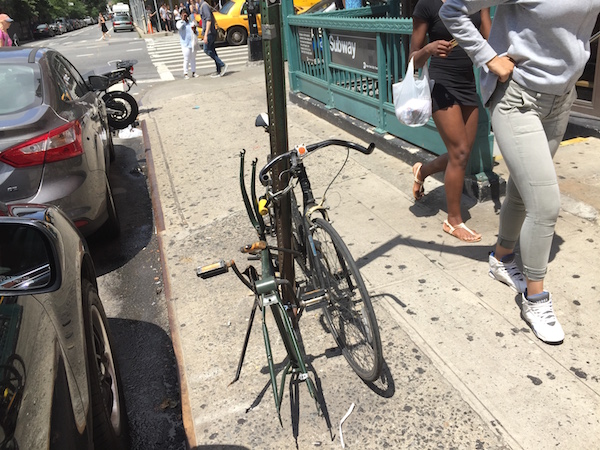
Starosta made two calls to 311 to report the forsaken bike frame. The first complaint was erroneously recorded at the wrong location, but the second prompted a phone call from a truculent DSNY supervisor, who tried to explain the bike did not fit the criteria for derelict bicycles, Starosta said.
“I asked him what are the criteria for a derelict bicycle. He said it has to be rusted, missing parts, and locked,” Starosta recalled. “I told him it fits all three.”
Starosta said the supervisor became irritated.
“He started to raise his voice and was acting rude. He said the case was closed and he wasn’t going to follow up,” said Starosta. “It felt like the Twilight Zone. This is just a rusted piece of metal. It should have been removed a long time ago.”
Starosta emailed the community board and the leader of his block association about the bike.
His account of trying to get the bike removed, which Starosta described as “a comedy of errors,” was followed and/or forwarded by members of block associations, CB4, and the Clinton Hell’s Kitchen Coalition for Pedestrian Safety (CHEKPEDS), until it reached the office of District 3 City Councilmember Corey Johnson. On July 19, Matt Green, Deputy Chief of Staff for Community Affairs for Johnson, wrote back (via “Reply All” to the email chain) that the DSNY agreed to tag the bike for removal.
However, as Chelsea Now went to press for its August 4 issue, there was no tag on the bike frame (Sanitation can return and remove the bicycle seven days after it’s been tagged).
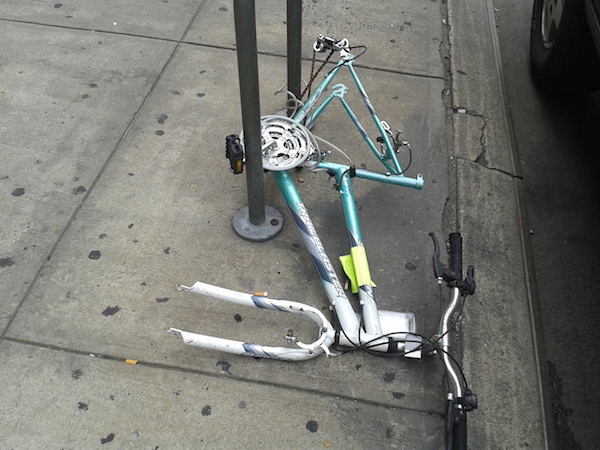
A DSNY spokesperson said the frame still did not meet the criteria for a derelict bicycle, which she clarified requires three or more of the following characteristics:
- The bicycle’s appearance is crushed or not usable;
- There are parts missing from the bicycle other than the seats and front wheels which are both commonly removed by the owner to prevent theft of bicycle;
- The bicycle has flat tires, or is missing its tires;
- The handlebars or pedals are damaged, or the forks, frames or rims that are present are bent;
- 75% of the bicycle — which includes the handlebars, pedals, frames — are rusted, along with the chain affixing the bicycle to public property.
The spokesperson also said the DSNY is reviewing rules on derelict bicycles and will hold a public hearing on the issue next week. Among the proposed rule changes, the agency is considering reducing the number of requirements from three to two, removing flat or missing tires from the criteria, and bringing the minimum amount of rust down to 50%.
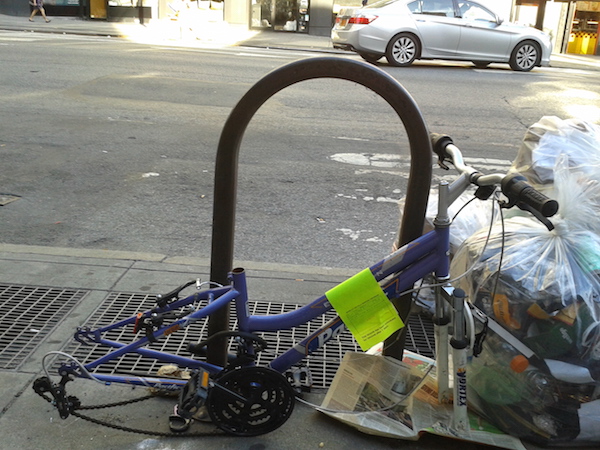
Examples of abandoned bikes can be found up and down Chelsea’s main thoroughfares, including one on Seventh Ave., between W. 24th and W. 23rd Sts. that was tagged for removal on July 23 (“This bicycle has been scheduled for removal after 7 days,” read a portion of the tag). In total, there have been 56 reports of derelict bicycles to 311 this year in Community District 4 — which covers Chelsea and Hell’s Kitchen. Of those, only four have been removed, according to city records.
In response to a growing number of complaints about derelict bicycles, DSNY revised its rules in 2010 to make the criteria more specific and easy to enforce. However, community advocates want the definition loosened and have called for reforms to speed up the removal of derelict bikes.
Last year, City Councilmember Brad Lander introduced legislation that would allow Sanitation to impound an abandoned bicycle after 36 hours — and require bike owners to pay a $25–$100 fine to get their rides back. However, DSNY Director of Cleaning and Collection Steve Costas said his department lacked the personnel to administer the policy, according to a transcript from a City Council hearing on the proposed legislation.
CB4 District Manager Jesse Bodine said board members have included a request for additional sanitation enforcement officers in their yearly statement of district needs since 2008.
“I think the guys on the job do what they can, but they have a lot of ground to cover,” he said of DSNY’s enforcement abilities.
Bodine explained that derelict bicycles, as well as other sidewalk obstructions like A-frame signs and unlawful outdoor cafes, are a “consistent concern” for the community.
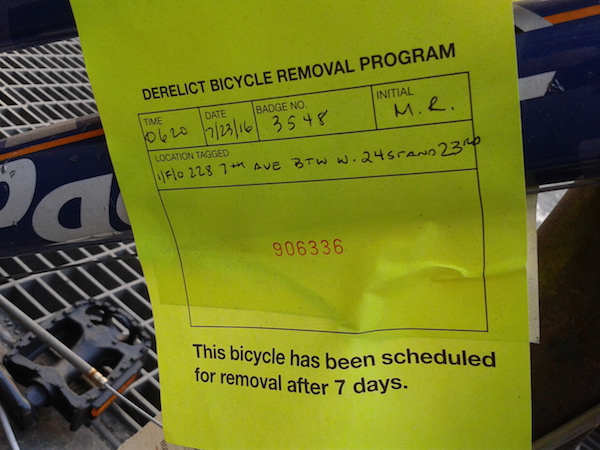
Stanley Bulbach, head of the West 15th Street 100 and 200 Block Association, said overcrowding in the neighborhood — spurred by a growing population, the new Google office building, and the addition of tourist attractions like the High Line and the Whitney Museum — has increased the need to keep sidewalks clear.
“We are hypersensitive in terms of what is going on around pedestrians. The sidewalks are so congested with people and obstructions that it’s a nuisance just to stop and talk to your neighbor. People slam into you,” he said.
Bulbach noted that calls to 311 rarely lead to a resolution and Starosta’s experience highlights the need for city agencies like DSNY to foster better relationships with the public.
“We need more cooperation,” he said. “The city depends a lot on the public to support their policies. Yet, the city is turning around and slamming the door in the public’s face.”
The public hearing on amending DSNY’s criteria for derelict bikes will be held Tues., Aug. 9, 10am–12pm, at 125 Worth St. (btw. Centre & Lafayette Sts.), Room 819.






























